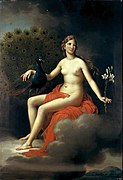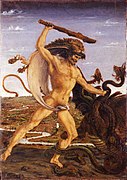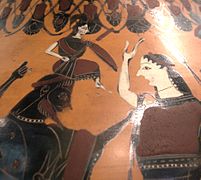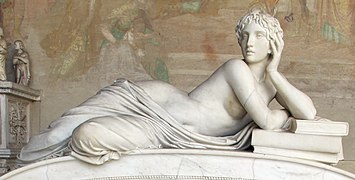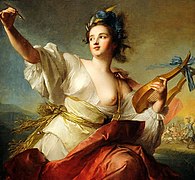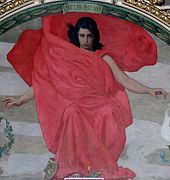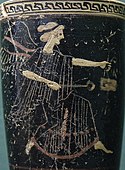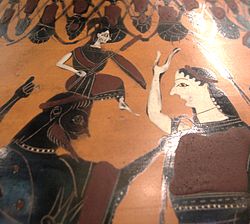Olympané

Olympané nebo olympští bohové nebo dvanáct olympských bohů či dvanáct olympanů (řecky Δωδεκάθεον, Dódekatheon) je název pro dvanáct nejvýznamnějších bohů v řecké mytologii. Dvanáct nejvyšších bohů měli vedle Řeků také Etruskové a Římané, a tyto dvanáctky byly obvykle ztotožňovány.
Tito bohové jsou označováni jako olympané podle toho, že sídlí na hoře Olymp. Nejvyšší z těchto bohů je Zeus, který zbavil svého otce Krona vlády nad světem, pak tam mají své místo někteří jeho sourozenci (včetně jeho manželky Héry), některé děti a bohyně Afrodíté zrozená z mořské pěny oplodněné useknutými genitáliemi boha Úrana. Některé seznamy uvádějí jako dvanáctou olympanku Diovu sestru Hestii, jiné upřednostňují jeho syna Dionýsa. Jmenovitě jsou tak součástí olympského panteonu:
- Zeus (syn Krona a Rheie, manžel Héry)
- Héra (dcera Krona a Rheie, manželka Dia)
- Poseidón (syn Krona a Rheie, manžel Amfitríté)
- Démétér (dcera Krona a Rheie)
- Pallas Athéna (dcera Dia a Métis)
- Foibos Apollón (syn Dia a Létó)
- Héfaistos (syn Dia a Héry, manžel Afrodíté)
- Hermés (syn Dia a Maie)
- Arés (syn Dia a Héry)
- Artemis (dcera Dia a Létó)
- Afrodíté (dcera Úrana a mořské pěny, manželka Héfaista)
- Dionýsos ( syn Dia a jeho milenky Semely)
- Foibos Apollón
Diův bratr Hádés a jeho manželka Persefoné se mezi olympany tradičně neřadí. Háda lze sice řadit k nejmocnějším a nejdůležitějším řeckým bohům, své sídlo má však ve své podsvětní říši, kde je neomezeným vladařem.
Na Olympu však přebývá také několik dalších božstev, která jsou často zosobněnými vlastnostmi bohů, případně se jedná o strážce Olympu či zdejší sloužící. V některých případech se jedná o Diovy nemanželské děti vzaté na Olymp. Zde je kompletní výčet ostatních obyvatel Olympu:
- (c) I, Sailko, CC BY-SA 3.0
Externí odkazy
 Obrázky, zvuky či videa k tématu Olympští bohové na Wikimedia Commons
Obrázky, zvuky či videa k tématu Olympští bohové na Wikimedia Commons
Média použitá na této stránce
Autor: Jean Housen, Licence: CC BY-SA 3.0
View of a statue of the Grace Aglaea from the Achilleion in Corfu.
Statue of Hestia. Margaret Clapp Library, Wellesley College, Wellesley, Massachusetts, USA.
This squat lekythos depicts Eutychia, Eunomia, and Paidia. On the left Eutychia stands frontally, looking right. She holds a chest on her left forearm at waist level; her right hand hangs down by her side holding a necklace. She wears a girded peplos, diadem, necklace, earring, and bracelets. Next is Eunomia who walks solemnly to the right, holding a necklace between her outstretched hands. She wears a girded peplos, necklace, bracelets, earring, diadem and a decorated band which holds her hair in place. On the right Paidia stands turned partially to the left, holding a chest. She wears a girded peplos, necklace, earring, and bracelets; her hair is tied in back. A diphros with a thick, patterned cushion stands beside her. The personifications on this vase, from left to right are to be understood as Good Luck, Good Order, and Games and Play. They are depicted as normal Athenian women and do nothing which might associate their actions with the literal meanings of their names.
Autor: Livioandronico2013, Licence: CC BY-SA 4.0
Apollo of the Belvedere
Illustration of the binding of Prometheus by John Flaxman, first published in Richard Porson's 1795 translation of Aeschylus's Prometheus Bound. Prometheus is shown in the center with Kratos and Bia on either side holding him down and Hephaestus behind him chaining him to the mountainside.
Autor: Ricardo André Frantz (User:Tetraktys), Licence: CC BY-SA 3.0
Aphrodite, National Archaeological Museum of Athens. Colors and background edited
Coin showing Dione on throne.
Black chalk drawing of the binding of Prometheus by George Romney, dating to circa 1798-1799. Kratos and Bia are at his feet, holding him down as Hephaestus binds his arms to the side of the rock.
Autor: Diosphos Painter, Licence: CC BY 3.0
Iris, Attic lekythos in Six's technique (superposed colours). From Tanagra.
Ganymede holding a hoop, symbol of his youth, and a cock, a traditional pederastic gift. Side A from an Attic red-figure bell-krater, ca. 500–490 BC. Side B: Zeus in pursuit.
Bust of Athena, type of the “Velletri Pallas” (inlaid eyes are lost). Copy of the 2nd century CE after a votive statue of Kresilas in Athens (ca. 430–420 BC).
Autor: Internet Archive Book Images, Licence: No restrictions
Identifier: grecianromanmyth00dwi (find matches)
Title: Grecian and Roman mythology
Year: 1876 (1870s)
Authors: Dwight, M. A. (Mary Ann), 1806-1858 Lewis, Tayler, 1802-1877
Subjects: Mythology, Classical
Publisher: New York Chicago : A.S. Barnes
Contributing Library: The Library of Congress
Digitizing Sponsor: The Library of Congress
View Book Page: Book Viewer
About This Book: Catalog Entry
View All Images: All Images From Book
Click here to view book online to see this illustration in context in a browseable online version of this book.
Text Appearing Before Image:
which sacerdotal influence seeks to record andprolong. With the Greeks, however, over whom none of this influencewas exercised, such an attribute becomes an object of secondary im-portance, and is considered the effect of caprice, or of the modesty ofa young female ; and the poets at one time throw doubts on its reality,and at another upon its duration. Yet, virgin as she is, Diana pre-sides over the birth of children, a combination in which no one canmistake the union of the power which destroys with that which creates.We see, then, how incoherent are the traces of sacerdotal ideas,which survive this strange metamorphosis. The Hertha of Scythia,the Bendis of Thrace, the Isis of Egypt, the Diana of Ephesus, thatmotionless, enigmatical, and fettered mummy, become, beneath Gre-cian skies, a young and active huntress, who, in her course as rapid asthe winds, pursues on the mountain tops the timid inhabitants of thewoods. Diana is always represented as taller by the head than her attend-
Text Appearing After Image:
ARTEMIS OR DIANA. 200 GRECIAN AND ROMAN MYTHOLOGY. ants ; her face somewhat manly, her legs bare, well shaped and strong,her feet sometimes bare, and sometimes covered with the cothurnus*or buskin of the ancient hunters. By poets and artists, she is repre-sented as armed with bow and arrows, and has threescore nymphs inher train. She is also represented with a quiver and attended bydogs, and sometimes drawn in a chariot by two white stags or hernymphs. Again, she appears with, wings, holding a lion with one handand a panther in the other; or in a chariot drawn by two horses, onewhite and one black. The representations of this goddess are generally known by thecrescent on her head, by the dogs which attend her, and by herhunting habit. Isis, Diana, and the Bull Apis, are decorated with thecrescent, which announced the commencement of a new moon. Thedogs and buskins more particularly mark the goddess of the chase, asthe crescent was often used by the ancients as an ornament to thefemale
Note About Images
Painting of the artist's second wife, Mariana Rita Gomes, as Erato, the Muse of love poetry, sometimes called "The Genius of the Arts", by António Manuel da Fonseca. She holds a medallion with the effigies of Queen Maria II of Portugal and her husband King Ferdinand II, patrons of the arts.
Athena is "born" from Zeus's forehead as a result of him having swallowed her mother Metis, as he grasps the clothing of Aphrodite on the right; black-figured amphora, 550–525 BC. Louvre, Paris
Autor:
So-called “Logios Hermes” (Hermes Orator). Marble, Roman copy from the late 1st century CE-early 2nd century CE after a Greek original of the 5th century BC.
Autor: Wikipedia Commons, Licence: CC BY-SA 4.0
Ο Άρης (Borghese-Λούβρου)
Autor: Jamain, Licence: CC BY-SA 4.0
Italy, ca 150 AD
Jupiter, king of the Roman gods, carrying a thunderbolt and accompagnied by and eagle. Marble. Louvre-Lens Museum, France.
Altar of the twelve gods, use unknown: maybe the brink of a well or an Zodiac altar. The object represents the twelve gods of the Roman pantheon, each identified by an attribute: Venus and Mars linked by Cupid, Jupiter and a lightning bolt, Minerva wearing a helmet, Apollo, Juno and her sceptre, Neptune and his trident, Vulcan and his sceptre, Mercury and his caduceus, Vesta, Diana and her quiver and Ceres. Marble, found in Gabii (Italy), 1st century CE.
(c) GearedBull na projektu Wikipedie v jazyce angličtina, CC BY 2.5
1886 sculpture of Astræa, signed "A," possibly the work of August St. Gaudens. Old Supreme Court Chamber, the Vermont State House, Montpelir, Vermont. August 2007.
Autor: MrPanyGoff, Licence: CC BY-SA 3.0
Statue of Euphrosyne, one of the "Three Graces", Goddess of Joy, Mirth and Merriment. Achilleion palace, Corfu island, Greece. A bust of Sophocles is in the background.
(c) Luis García, CC BY-SA 3.0
Roman statue of Demeter, of the Madrid-Capitol type.
(c) I, Sailko, CC BY-SA 3.0
Monumento di Ottaviano Fabrizio Massotti, con Urania di Giovanni Duprè

